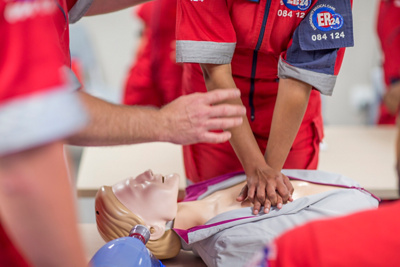Bystander CPR saves lives, says ER24 East Metro ALS Kurt Maske.
He describes how you can assist in a cardiac emergency.
Identifying a cardiac emergency
It's vital to recognise a cardiac emergency early. There are three types:
- Stable/unstable angina
- Myocardial infarction (heart attack)
- Heart failure.
Signs and symptoms:
Stable/unstable angina and myocardial infarction (heart attack)
- Chest pain or discomfort
- Feeling weak, light-headed, or faint
- Pain or discomfort in the jaw, neck, or back
- Pain or discomfort in one or both arms, or shoulders
- Shortness of breath.
Heart failure
- Rapid shallow respirations
- Chest discomfort
- Shortness of breath that is worsened when exerting themselves, e.g., climbing stairs. This can also be made worse when lying flat.
- In severe cases, patients may cough up pink frothy sputum (mixture of saliva and mucous) due to fluid accumulating in the lungs.
Don’t panic!
It’s important not to panic. Immediately call emergency services at 084 124. Share as many details as possible with the Contact Centre agent and try to keep the patient calm.
Place the patient in a position in which they are most comfortable, often semi-seated.
If they lose consciousness but are still breathing normally, place them on their side.
Hands on chest saves lives
If a patient is not breathing and there is no pulse, you need to administer cardiopulmonary resuscitation (CPR). CPR can double or triple a person's chance of survival if performed in the first few minutes of a cardiac arrest.
The CPR procedure:
- Lay the person on their back and open their airway (tilting their head back if no spinal injury is suspected).
- Check for breathing. If they are not breathing, start CPR.
- Trace your finger down the middle of the chest to a spot on the breastplate just below the nipples.
- Place the palm of one hand on this spot, and the other above this.
- Position your upper body over your hands and push down for one compression whilst keeping your elbows locked and arms straight. And then release to allow the chest to return to its normal state before you pressed. This allows the heart to refill with blood.
- Repeat the compressions at a rate between 100-120 per minte until paramedics arrive or an automated external defibrillator (AED) is available.
How to use a defibrillator (AED)
Paramedics will bring an automated external defibrillator (AED) when they arrive on scene, but sometimes establishments, businesses and schools have one as part of their first aid kit. If an AED becomes available, stop CPR and use the machine as described below:
- Turn on the AED and follow the voice prompts.
- Remove all clothing covering the chest. If necessary, wipe the chest dry.
- Place one pad on the upper right side of the chest.
- Place the other pad on the lower left side of the chest, just below the left armpit.
- Plug the pad connector cable into the AED, if not already connected.
- Let the AED analyse the heart’s rhythm.
- If the AED determines a shock is needed:
- Make sure no one is touching the person
- Say, “Clear!” in a loud, commanding voice
- Deliver the shock.
After the shock, immediately start CPR. Although the shock may have corrected the electrical rhythm, the heart is not yet pumping efficiently. Continue until the patient shows signs of life or medical help arrives.


